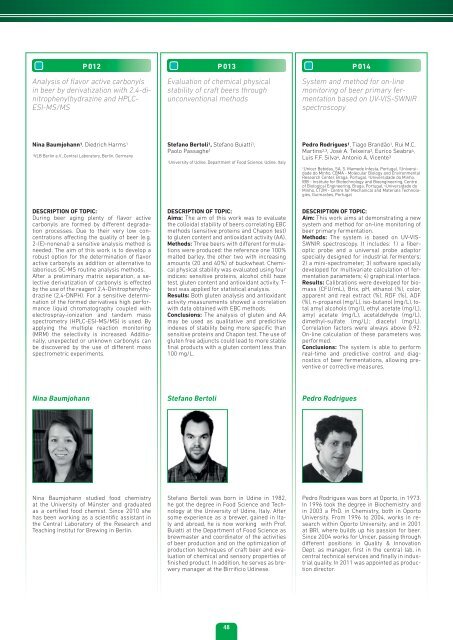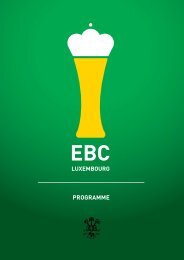please click here for download. - the 34th European Brewery ...
please click here for download. - the 34th European Brewery ...
please click here for download. - the 34th European Brewery ...
You also want an ePaper? Increase the reach of your titles
YUMPU automatically turns print PDFs into web optimized ePapers that Google loves.
P 012<br />
Analysis of flavor active carbonyls<br />
in beer by derivatization with 2,4-dinitrophenylhydrazine<br />
and HPLC-<br />
ESI-MS/MS<br />
P 013<br />
Evaluation of chemical physical<br />
stability of craft beers through<br />
unconventional methods<br />
P 014<br />
System and method <strong>for</strong> on-line<br />
monitoring of beer primary fermentation<br />
based on UV-VIS-SWNIR<br />
spectroscopy<br />
Nina Baumjohann 1 , Diedrich Harms 1<br />
1VLB Berlin e.V., Central Laboratory, Berlin, Germany<br />
Stefano Bertoli 1 , Stefano Buiatti 1 ,<br />
Paolo Passaghe 1<br />
1University of Udine, Department of Food Science, Udine, Italy<br />
Pedro Rodrigues 1 , Tiago Brandão 1 , Rui M.C.<br />
Martins 2,3 , José A. Teixeira 3 , Eurico Seabra 4 ,<br />
Luis F.F. Silva 4 , Antonio A. Vicente 3<br />
1Unicer Bebidas, SA, S. Mamede Infesta, Portugal, 2 Universidade<br />
do Minho, CBMA - Molecular Biology and Environmental<br />
Research Center, Braga, Portugal, 3 Universidade do Minho,<br />
IBB - Institute <strong>for</strong> Biotechnology and Bioengineering, Centre<br />
of Biological Engineering, Braga, Portugal, 4 Universidade do<br />
Minho, CT2M - Centre <strong>for</strong> Mechanical and Materials Technologies,<br />
Guimarães, Portugal<br />
DESCRIPTION OF TOPIC:<br />
During beer aging plenty of flavor active<br />
carbonyls are <strong>for</strong>med by different degradation<br />
processes. Due to <strong>the</strong>ir very low concentrations<br />
affecting <strong>the</strong> quality of beer (e.g.<br />
2-(E)-nonenal) a sensitive analysis method is<br />
needed. The aim of this work is to develop a<br />
robust option <strong>for</strong> <strong>the</strong> determination of flavor<br />
active carbonyls as addition or alternative to<br />
laborious GC-MS routine analysis methods.<br />
After a preliminary matrix separation, a selective<br />
derivatization of carbonyls is effected<br />
by <strong>the</strong> use of <strong>the</strong> reagent 2,4-Dinitrophenylhydrazine<br />
(2,4-DNPH). For a sensitive determination<br />
of <strong>the</strong> <strong>for</strong>med derivatives high per<strong>for</strong>mance<br />
liquid chromatography coupled with<br />
electrospray-ionization and tandem mass<br />
spectrometry (HPLC-ESI-MS/MS) is used. By<br />
applying <strong>the</strong> multiple reaction monitoring<br />
(MRM) <strong>the</strong> selectivity is increased. Additionally,<br />
unexpected or unknown carbonyls can<br />
be discovered by <strong>the</strong> use of different mass<br />
spectrometric experiments.<br />
DESCRIPTION OF TOPIC:<br />
Aims: The aim of this work was to evaluate<br />
<strong>the</strong> colloidal stability of beers correlating EBC<br />
methods (sensitive proteins and Chapon test)<br />
to gluten content and antioxidant activity (AA).<br />
Methods: Three beers with different <strong>for</strong>mulations<br />
were produced: <strong>the</strong> reference one 100%<br />
malted barley, <strong>the</strong> o<strong>the</strong>r two with increasing<br />
amounts (20 and 40%) of buckwheat. Chemical<br />
physical stability was evaluated using four<br />
indices: sensitive proteins, alcohol chill haze<br />
test, gluten content and antioxidant activity. T-<br />
test was applied <strong>for</strong> statistical analysis.<br />
Results: Both gluten analysis and antioxidant<br />
activity measurements showed a correlation<br />
with data obtained with EBC methods.<br />
Conclusions: The analysis of gluten and AA<br />
may be used as qualitative and predicitive<br />
indexes of stability being more specific than<br />
sensitive proteins and Chapon test. The use of<br />
gluten free adjuncts could lead to more stable<br />
final products with a gluten content less than<br />
100 mg/L.<br />
DESCRIPTION OF TOPIC:<br />
Aim: This work aims at demonstrating a new<br />
system and method <strong>for</strong> on-line monitoring of<br />
beer primary fermentation.<br />
Methods: The system is based on UV-VIS-<br />
SWNIR spectroscopy. It includes: 1) a fiberoptic<br />
probe and a universal probe adaptor<br />
specially designed <strong>for</strong> industrial fermenters;<br />
2) a mini-spectrometer; 3) software specially<br />
developed <strong>for</strong> multivariate calculation of fermentation<br />
parameters; 4) graphical interface.<br />
Results: Calibrations were developed <strong>for</strong> biomass<br />
(CFU/mL), Brix, pH, ethanol (%), color,<br />
apparent and real extract (%), RDF (%), ADF<br />
(%), n-propanol (mg/L), iso-butanol (mg/L), total<br />
amyl alcohols (mg/l), ethyl acetate (mg/L),<br />
amyl acetate (mg/L), acetaldehyde (mg/L),<br />
dimethyl-sulfate (mg/L); diacetyl (mg/L).<br />
Correlation factors were always above 0.92.<br />
On-line calculation of <strong>the</strong>se parameters was<br />
per<strong>for</strong>med.<br />
Conclusions: The system is able to per<strong>for</strong>m<br />
real-time and predictive control and diagnostics<br />
of beer fermentations, allowing preventive<br />
or corrective measures.<br />
Nina Baumjohann<br />
Stefano Bertoli<br />
Pedro Rodrigues<br />
Nina Baumjohann studied food chemistry<br />
at <strong>the</strong> University of Münster and graduated<br />
as a certified food chemist. Since 2010 she<br />
has been working as a scientific assistant in<br />
<strong>the</strong> Central Laboratory of <strong>the</strong> Research and<br />
Teaching Institut <strong>for</strong> Brewing in Berlin.<br />
Stefano Bertoli was born in Udine in 1982,<br />
he got <strong>the</strong> degree in Food Science and Technology<br />
at <strong>the</strong> University of Udine, Italy. After<br />
some experience as a brewer, gained in Italy<br />
and abroad, he is now working with Prof.<br />
Buiatti at <strong>the</strong> Department of Food Science as<br />
brewmaster and coordinator of <strong>the</strong> activities<br />
of beer production and on <strong>the</strong> optimization of<br />
production techniques of craft beer and evaluation<br />
of chemical and sensory properties of<br />
finished product. In addition, he serves as brewery<br />
manager at <strong>the</strong> Birrificio Udinese.<br />
Pedro Rodrigues was born at Oporto, in 1973.<br />
In 1996 took <strong>the</strong> degree in Biochemistry and<br />
in 2003 a PhD. in Chemistry, both in Oporto<br />
University. From 1996 to 2004, works in research<br />
within Oporto University, and in 2001<br />
at BRI, w<strong>here</strong> builds up his passion <strong>for</strong> beer.<br />
Since 2004 works <strong>for</strong> Unicer, passing through<br />
different positions in Quality & Innovation<br />
Dept. as manager, first in <strong>the</strong> central lab, in<br />
central technical services and finally in industrial<br />
quality. In 2011 was appointed as production<br />
director.<br />
48





